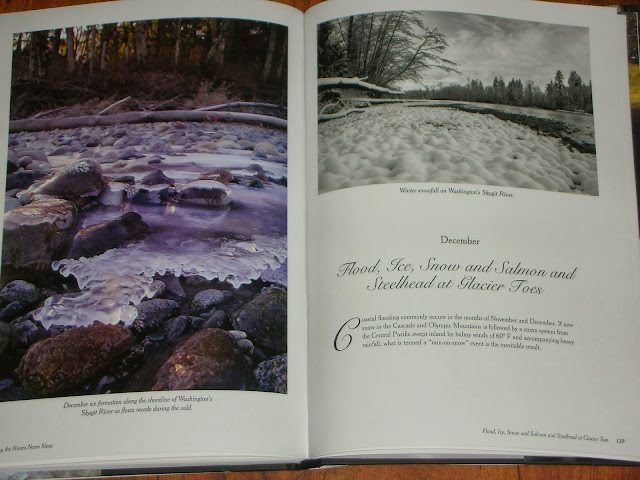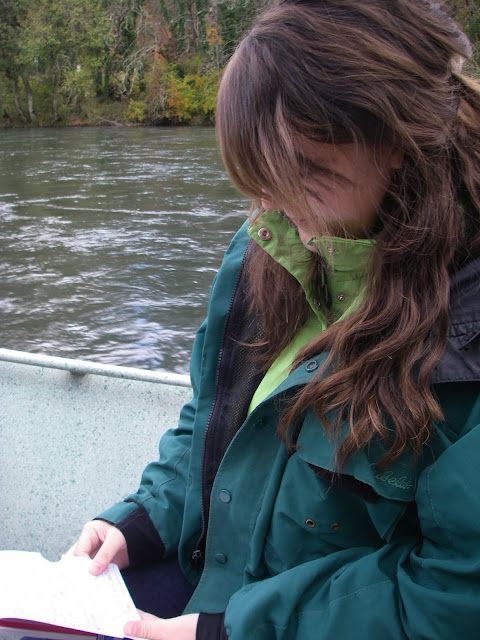About a month or so ago, I received a message through the Speypages board from James Reid, a very talented contemporary bamboo rod maker. In this message James inquired if I fished single hand rods throughout the winter steelhead season and if I'd like to field test a cane single hand prototype that he was designing for winter steelheading. I'm not one to miss out on unexpected opporturnities and blessings, so my responses to James's questions were yes.... and HECK yes!!
Apparently, my crazed dry line winter steelhead posts got James's attention and he chose me as a candidate to put his prototype through the Oregon Winter Steelhead Acid test. James asked me to fish the rod hard, not baby it, and test it out with various lines and techniques.
The rod turned out to be 8' 5" and rated as a nine weight. It is a splice jointed rod, with the splice slightly below the halfway point. James stayed in contact with me as he neared completion of the rod and by early December, he took advantage of using USPS (rather than shipping from Canada) when he came down to Washington for A Day On The River through River Run fly shop on the Snoqualime river.
James had warned that the prototype would be "spartan" in it appointments and that it was "cosmetically subpar", but he could have fooled me, because when I excitedly took it out of it's rod tube for the first time, it was genuine beauty to behold. The finish, wraps, handle, reel seat, and hardware are all first rate
I was hoping to give the rod an immediate test on Oregon winter steelhead, but Christmas activities provided a distraction from heading to the coast. Instead, I was able to beg a couple quick local trips from my wife to hit the MF Willamette below Dexter dam for some initial test casting and fishing over some late summer runs. Upon arriving at the parking area, I taped the spliced joint on the rod and mounted my favorite 3 7/8 Hardy Perfect loaded with a 350 gr Ambush head on the reel seat.
Most of the time, there was a slight upstream breeze prompting single spey and snap t casts on river left. This rod easily flung tight loops carrying 10-11 strips of running line out behind the Ambush head. The rod is light in hand and it's swing weight and balance were perfect. This rod is actually crisp and powerful, not what one may expect from a cane rod. Even at 8' 5" and rated for a nine weight line, I could cast this rod all day without tiring. I was casting a 2/0 Winter's Hope on a 12' Maxima leader with the Winter Dry Line Swing method and the rod really shined while I fished my preferred technique.
When the wind briefly blew downstream I was easily able to make cack handed double speys while using the short bottom handle for compact two handed casting. I was also able to two hand cast snap Ts and single speys using compact casting strokes while employing the bottom grip as well.
I recently spent a several full days on a favorite coastal river in search of some early winter steelhead. As I got more and more familiar with the ferrule taping process, it becomes second nature to quickly get the rod setup for a days fishing. On each of these days, I spent up to 7 straight hours casting and fishing this rod. I tried a few different lines, but settled on the fully integrated 9wt/350 grain Wulff Ambush line as my favorite line on this rod. The short aggressive head (20') allows easy single hand spey casting with the relatively short length of this rod and when deep wading. The seamless transition from the head to the running line allows ease in adding hauls to the backcast (d loop formation) and forward cast - a double hauled spey cast.
As an angler who up to now, has never had the opportunity to fish with a cane rod, I was pleasantly surprised with the crisp, powerful action of this rod. The hollow six strip design seems to help the rod track very straight with no tip wobble on the cast.
James informed me that part of the push for the design of this rod is to be able to offer customers the option of owning both a single hand and double hand rod for relatively little additional cost. The tip section of the rod I am field testing is the same tip section used on James's 13' 7/8 classic spey model. This is a cool idea for folks who would want the luxury of having the option of fishing a double hand or single hand cane rod.
Visit the JM Reid website for some drool worthy browsing of James's masterworks:
http://www.jmreidbamboo.com/
(This review was also posted on the Speypages board)
Happy New Year to all and a Blessed 2014!
Todd
























































